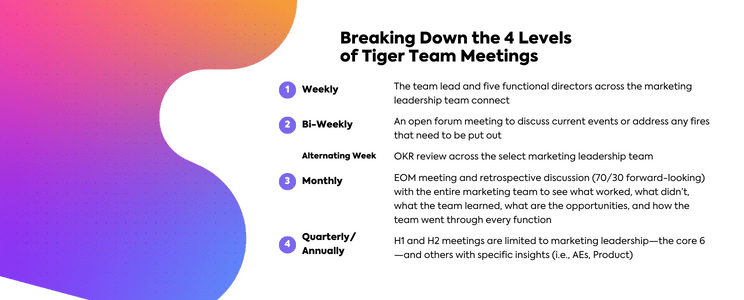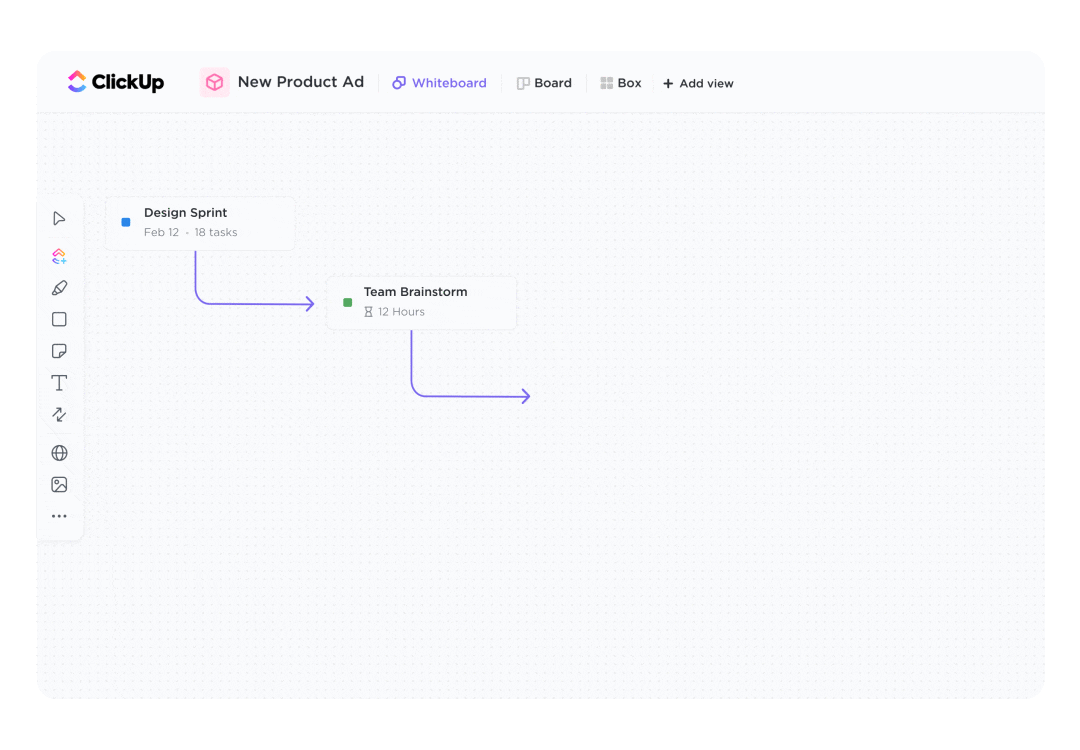

You’ve definitely heard the phrase “Houston, we have a problem.”
But what about tiger teams? 🐅
Coined in the 1964 paper, Program Management in Design and Development, tiger teams were made famous by NASA, who formed one to investigate the Apollo 13 malfunction and bring the astronauts to safety. 🌕
That task force won the Presidential Medal of Freedom for their work. While we can’t guarantee the same degree of recognition, we can certainly help you build a tiger team approach to your organization’s needs so you succeed.
Since the lunar mission in 1970, government entities and businesses around the world have deployed tiger teams to keep operations running smoothly. The diverse and highly specialized tiger team approach was created with the sole purpose of solving a specific (and often complex) problem plaguing the larger organization.
Like any proven strategy, there’s an art to forming the perfect tiger team. But with the right tools, we’re confident you can use this method to your greatest advantage. Follow along as we uncover everything you need to know about tiger teams before you set one loose in your org.
Find out what they are, their benefits, best practices, and how ClickUp’s own VP of Marketing uses tiger teams to drive success.
What is a Tiger Team?
A tiger team is a small, cross-functional group of experts within your organization who come together to solve a complex issue. Different than your typical problem-oriented team, tiger teams not only find a resolution but develop systems to effectively implement the solution.
Tiger teams are formed in one of two ways:
- A team is created specifically to address a certain problem. All tiger team duties take priority over each member’s typical role, and when the goal is achieved, they return to their usual day-to-day responsibilities
- A team is created to address a certain problem or meet a specific goal in addition to their current workload. This tiger team approach might require a daily or weekly time block on their calendars devoted to the cause, but won’t drop their typical schedule to resolve the issue
The approach you choose depends on the nature of the objective and the allotted time you have to reach it. Perhaps your tiger team members meet consistently over an extended period or frequently within a limited time frame. Regardless, it must have the ability to pivot and act quickly if needed.
Tiger teams should consist of members from across different departments or branches of your organization to contribute a broad range of skills. The goal is to create a diverse think tank of senior-level members who bring years of experience, expertise, and perspectives to the table.
This uniquely positions your tiger team to spot bottlenecks, areas of interest, and solutions that the average team might’ve missed. It’s all about leveraging the collective skills and knowledge of your internal subject matter experts to identify innovative solutions and game plans for problems your business is facing.
Sounds simple enough, right? Not exactly—but the outcome is well worth it.
The challenges and benefits behind the tiger team approach
Your higher-ups will be the first to tell you that cross-functional teamwork is an ongoing challenge. It’s also the foundation of any successful tiger team.
Done correctly, cross-functional collaboration eliminates team silos, encourages creativity, promotes healthy working relationships, and boosts productivity. But when it’s unsuccessful, a cross-functional team can quickly feel like too many cooks in the kitchen.
Amrita Mathur, VP of Marketing at ClickUp, knows all about the trials, tribulations, and significant benefits of tiger teams. They’re one of the key strategies she carried over to ClickUp from Superside, where she grew the company from virtually zero to $45 million in annual recurring revenue (ARR) in just four years.
Her secret? A strategic meeting breakdown to keep every need-to-know member in the loop while maintaining a healthy, fully remote work culture.

Bonus: Read Amrita’s interview with Growth Sprints for an in-depth breakdown of the top meeting and collaboration strategies that helped Superside scale.
Breaking down silos among your team or business isn’t a one-and-done deal, it’s a muscle that requires patience, consistency, and intentional effort. Otherwise, your team silos simply return and often take root deeper in your organization.
Ensuring your tiger team extends to the most skilled and mature experts is the best way to combat this challenge. The select technical team tasked will have extensive experience working on cross-functional projects, and can swiftly remove any communication barriers to address new roadblocks from the jump.
By keeping the team lean, it can act on its decisions as quickly as possible (without being bogged down by complex processes or stakeholder approvals). Other major benefits of a well-oiled tiger team include:
- Strategic decision-making with enough prior experience and forethought to consider the impact
- The ability to analyze complex problems from multiple perspectives
- Immediate access to resources, data, insights, and more from across the organization
- Interest in new business processes, creative solutions, and innovation
- A positive and proactive outlook on unforeseen obstacles
Efficient tiger teams are also one of the most cost-effective ways to optimize your internal strategy. With more than half of executives reporting resource efficiency as their top priority in a recent ClickUp study, this focus-group style of problem-solving may become even more prevalent across industries.
When to Use a Tiger Team
Tiger teams aren’t an everyday occurrence. And since they are structured on a case-by-case basis, it’s very possible that no two tiger teams will ever share the same group members, even without organizational changes.
These specialized task forces are built to target the critical issues holding a company back from reaching larger goals or completing a high-impact project—i.e., a stubborn bug is keeping customers from properly using your product, or a major initiative keeps failing and you need to investigate a new plan of attack.

Before you start your tiger team approach, it’s important to consider whether this strategy is the best option for your situation. Ask yourself:
- Have all other possible solutions been attempted to fix the problem?
- Can you clearly define the problem that needs to be solved?
- Are you dealing with a complex problem that requires insight from diverse points of view?
- Is the problem time-sensitive and vital to the success of the business?
Answering these questions will help determine whether it’s time to form a tiger team while also sparking the right discussion points to solidify the project scope.
Who’s on Your Tiger Team?
There are no hard and fast rules when it comes to who’s on your A-squad, it all depends on the scope of your organization, problem, and goal.
Your ideal members are easy to work with, proactive, and not afraid to push the norms or disrupt long-held business practices for the good of the company.
Consult your org chart software and look beyond the top performers to find dynamic members with a range of professional experiences under their belts (both technical and non-technical).

Bear in mind that two or three-member tiger teams are fairly common, although more complex projects may require teams of 10 or more. All this to say, a spot on your tiger team is extremely valuable and these decisions should be made with the utmost care and consideration.
3 Steps to Build Your Tiger Team
We suggest starting with a set of criteria based on the problem your tiger team will be tasked with and the necessary skills to solve it. While you want to keep the team small, don’t be afraid to think broadly when brainstorming potential members—particularly in terms of their specialties.
Follow these three simple steps to stack your tiger team with all of the right players:
Step 1: Define the problem
Establish the who, what, where, why, and how of the problem you’re taking on before you start building the team. Use these factors to consider the root cause of the problem and what might be needed to reach a resolution.

Nailing down these characteristics will help you think critically about which teams are most impacted by this issue, the project’s needs, and the overall complexity. Setting clear parameters on the project scope early on will keep the team on-task when the real work begins and prevent unnecessary deliverables from piling onto the project—AKA, scope creep.
Step 2: Identify your key player’s top skills
A balanced and efficient tiger team consists of seasoned experts who understand the problem from every angle—including risks, stakes, and setbacks. With a well-defined problem in mind, ask yourself:
- Which teams or departments are impacted by this issue?
- What type of solution will this issue require?
- Who has the most insight into this problem?
More technical projects may require additional lift from your engineering or product teams, but variety is crucial.
Too many members with overly similar or hyper-specific specialties will slow down progress, create blind spots in the team’s logic, and potentially exclude valuable perspectives from the conversation. Instead, look past job titles alone to compose a team of diverse backgrounds, strengths, and familiarity with the issue.
Step 3: Decide who will lead the way
With members in place, it’s time to assign a tiger team leader.
This individual will act as the group moderator, spokesperson, and sponsor for additional resources if needed. Simply put—this is a huge role and possibly the make-or-break factor in whether your tiger team meets its objective.
One study found that 76% of the successful cross-functional teams it surveyed shared one commonality—a strong governing voice among the group.
Your tiger team leader may have the final say over the group’s major decisions, but they must also encourage participation, open discourse, and collaboration from all team members. Failure to do so may result in solutions falling through the cracks or leaving the problem unresolved.

Tiger Team Best Practices and Strategies
Alexa, play “Eye of the Tiger” by Survivor.
Now that we’ve covered the basics and set the scene, let’s dive into the strategies and best practices to lead your tiger team to victory:
- Prepare, prepare, prepare: Before your tiger team’s first meeting, set them up for success by gathering as much information as possible for fast referencing and necessary context. As the team’s project manager, ensure they have access to all relevant data, insights, budgets, and resources to understand how this problem began in order to solve it
- Set SMART goals: Establish specific, measurable, attainable, realistic, and timely (SMART) goals to align each member with what needs to be accomplished and why
- Think iteratively: Tiger teams likely won’t solve problems overnight. It will take trial and error, plus, gradual progress week over week to follow the roadmap drawn out by your team of experts
- Encourage open discussions: Transparency is key to an effective tiger team. Open communication fosters honest feedback, camaraderie, innovation, productive conversations, and more
- Project documentation is everything: From each member’s role and responsibilities to your day-by-day progress—write everything down. Keep track of how things are going to easily pick up the discussion where you left off or spot bottlenecks before it’s too late
- Define your communication channels: Efficiency is everything for your tiger team, and while in-person brainstorming is ideal, it’s not always feasible. Before your best ideas get lost in an email inbox while the rest of the team is chatting in Slack, set clear expectations as to how you’ll all communicate with each other throughout the process in real-time and asynchronously
- Celebrate your wins: Morale is everything! Give recognition where it’s due and celebrate your team for every victory, no matter how big or small

Adopting these practices early on will ensure your tiger team maintains its strategic direction throughout the problem-solving process and prevent scope creep from veering the team off course among other common mistakes. But the greatest resource for a tiger team of any size or industry is to invest in powerful project management software to store their work.
Take Your Tiger Team Further With ClickUp
For fully remote or fully asynchronous teams, it’s crucial to dedicate a space for tiger team members to connect, collaborate, and execute their best ideas. Our suggestion? ClickUp.
All-in-one project management solutions like ClickUp are packed with the tools needed to effectively develop solutions for problems of any scale. With the ability to delegate action items, edit documents, arrange schedules, plan timelines, and track progress, ClickUp mirrors the fast-paced excitement and efficiency of in-person brainstorming sessions in a single collaborative platform—and then some.
Teams across industries rely on ClickUp for its flexibility, rich set of features, and range of integrations to connect their work from virtually any app. Plus, its vast Template Library makes it easy to customize your Workspace and hit the ground running on your most important tasks.
But don’t take our word for it—see for yourself when you sign up for ClickUp today.





